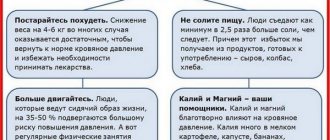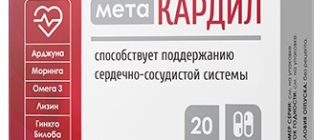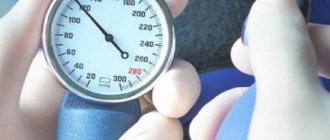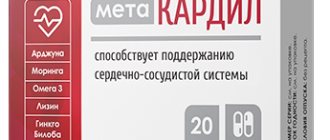A blood pressure of 120 over 80 is considered normal. This common myth still lives in the minds of most. Is it really? Far from it.
The World Health Organization has not established a clear static value, but a range. A normal blood pressure level is considered to be from 90 over 60 to 140 over 90 or so, with minor deviations and adjustments to the so-called individual norm. It cannot exceed 10 mmHg in both directions.
Thus, a tonometer reading of 140 to 100 means normal. But is it always? No, not always either.
If a person walks at this level and has a normal upper pressure of 140 and a lower pressure of 90, then we can talk about a variant of the physiological norm. Otherwise, there is mild or severe hypertension or hypertension (depending on the etiology of the condition, it can be called either one way or another).
Each specific case must be analyzed separately; there are no single universal calculations.
What do you need to know about normal blood pressure levels in different age and gender categories?
Is this blood pressure normal, 140 over 100?
As already mentioned, when assessing the level of blood pressure, you need to start from the norms, as well as individual working indicators (constant indicators) of a particular person.
Without knowing the patient, we can only speak approximately about the state of health. Therefore, it is recommended to be observed on a regular basis by the same cardiologist, who already knows about the characteristics of the cardiovascular system of a particular person.
When assessing the nature of blood pressure deviations from the norm, it is necessary to take into account a whole group of factors: the patient’s gender, age, general health and the presence of somatic diseases, characteristics of professional activity, and others.
Children and teenagers
In children under 9 years of age, tonometer readings of 140 to 100 are a clear pathology. Children should not have such high blood pressure. What kind of disease occurs needs to be examined separately.
For teenagers from 9-12 to 19 years old, everything is somewhat more complicated. During these years, puberty (puberty) is in full swing. During the development of the body, an intense hormonal surge is observed, the level of blood pressure at this age is unstable: hypertension is replaced by severe hypotension, and cyclical changes are noted throughout the day, which is clearly visible during monitoring. The duration of this state is years.
But, paradoxically, the body tolerates this phenomenon normally. There is no danger. But, if the numbers continue to creep up, especially the diastolic (lower) reading is over 100, and the patient feels unwell, medical attention is needed.
Moreover, if puberty is far behind, and the pressure does not suspect it.
Gender
It is not known exactly for what reason, but in representatives of the fairer sex, tonometer readings are several mm Hg higher than in men. What has been said is not an axiom; different options are possible. A blood pressure of 140 over 100 in men may also be normal.
Nature of therapy
If the patient is treated with drugs, this may affect blood pressure levels. Hypertension is caused by psychotropic medications, some antidepressants and mood stabilizers, non-steroidal anti-inflammatory drugs, and glucocorticoids in any dosage. This must be taken into account when assessing the situation and prescribing treatment.
Features of endocrine status
There are 4 peak hormonal states that greatly influence the cardiovascular system: puberty, menstrual cycle, pregnancy and menopause.
The menstrual cycle is associated with hormonal changes. The concentration of estrogen and progesterone increases. This is where all the problems come from.
Menopause and the periods before and after its onset are accompanied by a drop in estrogen concentrations. As a result, the elasticity of blood vessels decreases and the normal tone of the arteries is disrupted.
At the same time, menopause is also typical for men of different ages (from 45 to 50 years, as a rule, much earlier for smokers).
Pregnancy
For women during gestation, low blood pressure is much more common than high blood pressure. Therefore, a patient with high blood pressure levels needs to be examined more carefully. The higher the pressure level, the greater the risks for the fetus and the expectant mother herself.
Elderly age
In older patients, blood pressure levels are 140 per 100 mmHg. Art. not quite normal, but quite an acceptable option. Considering that vascular tone decreases and arterial regulation is disrupted, heart pathologies develop.
Features of professional activity
In workers of heavy industries and physical labor, arterial hypertension occurs several times more often.
Thus, pressure within the specified limits can be considered normal. But not always and not for everyone. Possible floating norm: 140 per 100 mmHg. Art., 140 to 96, etc.
Boost Mechanism
Blood pressure (BP) is an important indicator of the functional state of the cardiovascular system.
Several physiological mechanisms take part in its formation:
- Resistance of the walls of arterial vessels, which is possible due to their elasticity.
- The ratio of the volume of circulating blood to the total volume of the vascular bed.
- The work of the heart, which performs a pumping function.
The pressure indicator contains 2 numbers: upper (systolic) and lower (diastolic) indicator. The average normal value is 130-140 per 80 mmHg. Art. If diastolic pressure is increased to a greater extent (100 mm Hg and above), then this indicates predominant changes in the vessels.
What does a heart rate of 90-100 beats per minute indicate?
Hypertension is usually associated with increased work of the heart and blood vessels in general. Therefore, tachycardia, even more pronounced (up to 120 bpm), but it says little.
It only states the fact that the disease exists. Neither etiology nor pathogenesis can be understood by the number of heart beats per minute alone.
The pulse indicator plays a role only as a symptom that needs to be stopped to prevent dangerous consequences for health and life.
The following pathological processes most often occur with a high heart rate:
- Hypercortisolism or Itsenko-Cushing's disease. Severe endocrine pathology, accompanied by increased synthesis of cortisol. As a result of the course of the pathology, the blood pressure level rises to significant levels, 140/100 is a mild option. It is not difficult to identify the patient even by external signs. Causes: tumors of the pituitary gland (corticotropinoma), adrenal cortex. Urgent treatment is required.
- Hyperthyroidism or increased concentration of thyroid hormones in the bloodstream. The described condition is somewhat less common. It occurs in various variants: a latent (sluggish) course is possible, or it can be bright, with a characteristic clinical picture and high blood pressure levels.
- Atherosclerosis of large blood vessels. It develops in people of all ages, predominantly affecting elderly patients. The essence of the pathology is the formation of cholesterol plaques on the walls of blood vessels. Over time, they become covered with calcium salts and harden, not amenable to treatment. A possible option is long-term arterial stenosis. As a result, the blood has to overcome additional resistance, which causes a pressure of 140-146 per 100-104 or more with a pulse of 80-90 beats per minute.
- Kidney pathologies. A whole heterogeneous group of conditions. Including pyelonephritis, nephritis, nephropathy, glomerulonephritis, etc. The process is accompanied by intense swelling as a result of fluid retention in the body, pain, disturbances in normal urination, and changes in the volume of daily diuresis.
The causes of pressure 140 over 100 are different, but almost always they cause tachycardia (heart rate more than 90 beats per minute).
High blood pressure and headaches: together or apart?
Hypertension is deceptive. It can be completely asymptomatic - it’s not for nothing that it’s called the silent killer.
At the same time, many are sure that they will certainly feel it if the pressure “jumps.”
And a headache in the back of the head is secretly the leader among those considered classic signs of hypertension. Does high blood pressure really cause headaches?
Blood Power
To understand how hypertension can manifest itself and why, it would be good to understand what happens in the body when pressure increases.
So, when the heart contracts, blood is pushed into the vessels - through them it penetrates into the tissues. In order for blood rich in oxygen and nutrients to reach every cell of the body, it must be ejected from the heart with a certain force, which, in turn, puts pressure on the blood vessels. It is this force that is considered blood pressure.
The level of pressure is determined by many factors. It depends on the force with which the heart pumps blood into the vessels, the volume of blood entering the arteries, the elasticity of the vessels and many other aspects. Therefore, the famous norm is 120/80 mm Hg. can vary both downward and upward.
However, if the threshold of 140/90 mmHg is exceeded. blood pressure is considered abnormally elevated.
If blood pressure rises regularly, arterial hypertension develops. It “approaches” imperceptibly: usually the numbers increase gradually, and the body adapts to the change in the force with which the blood presses on the walls of the blood vessels. Therefore, even with constantly high blood pressure, a person often feels great, which is confirmed by data from numerous studies studying the relationship between hypertension and its possible manifestations, including headaches.
Does not hurt…
In fact, many scientific studies have shown that there is no connection between headaches and increased blood pressure. Moreover: it has been proven that regular headaches do not affect the condition of a patient with hypertension.
Thus, the American Journal of Hypertension published the results of a large-scale study in which 1914 patients with arterial hypertension participated. Scientists observed them for three long decades, recording the symptoms, course and complications of the disease.
The results of the experiment showed that there is no connection between the regular occurrence of headaches and the likelihood of cardiovascular death.
This indirectly confirms that headache is not related to hypertension.
The lack of connection between headaches and hypertension is confirmed by many cardiological organizations, for example, the American Heart Association. Its experts have published data showing that patients with arterial hypertension are less likely to experience headaches than those with normal blood pressure. And yet there is an opposite opinion.
...or does it hurt?
The fact is that a sudden and sharp increase in blood pressure, known as a hypertensive crisis, can cause an increase in pressure inside the skull - in the sinuses of the brain, ventricles of the brain and other structures. This may result in a headache that is different from a “traditional” tension headache or migraine attack.
According to some experts, this pain is pulsating in nature and can intensify with physical activity. It is often felt in the back of the head, although its location may be different.
Some other symptoms may indicate a significant increase in blood pressure, in particular:
- Facial redness
- Weakness
- Dyspnea
- Visual impairment
- Chest pain, palpitations, irregular heart rhythm
- Nausea
- Severe anxiety or, conversely, lethargy
- Sweating
- Nose bleed.
If you experience a severe headache along with blurred vision and confusion, you should immediately call the emergency room - the combination of these symptoms may indicate organ damage and the need for emergency medical care. But in other cases it is better not to hesitate.
What to do?
For headaches that occur against the background of a hypertensive crisis, it is important to take measures to lower blood pressure as quickly as possible. We must not forget that a sharp drop in it is just as undesirable as a sudden increase. During the first two hours, pressure should be reduced by no more than 25%, and target values (i.e. normal) should be achieved within 2-6 hours after the onset of the attack.
Is it necessary to reduce this pressure?
Again, you should look at the situation. If this is a normal indicator for a person, you don’t need to do anything, everything is fine. Otherwise, complex antihypertensive therapy should be carried out. Strictly under the supervision of a cardiologist.
Amateur activities are excluded to avoid unnecessary consequences. If treated incorrectly, resistant (drug-resistant) variants of hypertension may develop.
Then it will become almost impossible to choose adequate treatment, the body will adapt to new conditions and the drugs will not have an effect.
How can you help yourself at home?
The best thing you can do if your blood pressure is 140/100 or more is to take a semi-sitting position. Bend your legs. Take the prescribed drug in the required dosage and wait for improvement.
If therapy has not yet been prescribed and the blood pressure has increased to 140/100, you need to take mild herbal-based sedatives, such as valerian or motherwort in tablets (not in alcohol solution), medications containing barbiturates (Valocordin, Corvalol and their analogues).
These remedies will gently and safely lower blood pressure levels. No showers, rubbing, hot baths or anything else described on the Internet. This is deadly.
If a person feels unwell, in addition to the above measures, an ambulance should be called to carry out appropriate measures.
Symptoms requiring medical attention
It is necessary to consult a doctor if you have one or, especially, several of the described manifestations of the cardiovascular system:
- Pain syndrome in the head area. Usually of a stabbing nature, pressing pain, aching.
- Dizziness. Especially if it lasts longer than 2 hours and occurs on a regular basis.
- Vomit. Repeated, not bringing relief.
- Sweating for no apparent reason. Patients with high blood pressure literally pour out sweat. The body tries in vain to cool down and put itself in order.
- Regular tachycardia. Especially if it manifests itself in a calm state or after eating.
Even more serious symptoms requiring emergency care
- Shortness of breath, suffocation.
- Severe headache, forcing one to take a certain position. It is not relieved by analgesic drugs.
- Back pain accompanied by chest pain.
- Pain behind the sternum is intense, intensifies with breathing and movement.
- Fainting conditions.
- Impaired functioning of the body muscles (shaky gait, difficulty speaking, lack of clarity in the facial muscles).
There is no need to expect the condition to stabilize on its own. A doctor's call is required.
Symptoms of the first degree of hypertension
At the initial stage, it is difficult to recognize hypertension. Typically, the first degree of hypertension is asymptomatic. At 140/100, the following body reactions may appear:
- prolonged pain in the head;
- weakness;
- malaise;
- gagging;
- noise in ears;
- visual impairment;
- increased heart rate;
- black spots before the eyes;
- apathy;
- nervousness;
- hyperhidrosis;
- swelling of tissues;
- numbness of the phalanges of the fingers;
- chills.
If any of the symptoms appear regularly, you need to go to the hospital to determine the diagnosis and rule out hypertension.
Symptoms of hypertension
Diagnostics
Diagnosis is carried out under the supervision of a cardiologist and other specialized specialists if there are indications: endocrinologist, nephrologist, neurologist.
The list of studies is standard:
- Oral interview with the patient. The doctor asks the patient about complaints about the condition and records all the data in writing.
- Anamnesis collection. It is important to identify lifestyle, bad habits, diet, and the presence of somatic diseases that could cause an increase in blood pressure.
- Blood pressure level measurement. To establish the fact of a hypertensive process.
- Daily monitoring using an automatic tonometer. It is considered the gold standard for early diagnosis and monitoring of the patient over time.
- Electrocardiography.
- Study of the condition of the heart muscle using a special device (echocardiography).
- Assessment of neurological status.
- Encephalography.
- Study of hormone levels in venous blood (T3, T4, TSH, cortisol and some others).
- Assessing the condition of the kidneys using ultrasound and tests. It is possible to use a tomograph.
- Load tests (conducted with great care).
The examinations are shown in the system.
Treatment regimens
Therapy is etiological, that is, aimed at eliminating the root cause of the pathological condition (kidney, thyroid, and other diagnosed diseases). This is the basis of treatment. Everything else is just additional measures designed to combat only manifestations and symptoms.
The first without the second makes no sense. To solve the problem of relieving symptoms, antihypertensive drugs are prescribed (several pharmaceutical groups at once, a complex effect is most preferable).
As an auxiliary measure, adherence to an optimal drinking regimen (2 liters of fluid per day), diet, and giving up bad habits is indicated. You should not take medications without a doctor's recommendation. What this entails has already been said.
The outcome of treatment in most cases is favorable if you follow all the specialist’s recommendations and do not engage in amateur activities.
Causes (etiology)
High blood pressure (hypertension) is a polyetiological condition.
This means that it develops due to the influence of a significant number of factors, the most common of which include:
- Hereditary predisposition that determines the functional state of the vascular bed.
- Atherosclerotic changes in the arteries, which are the deposition of cholesterol in the walls with the formation of plaques. This leads to a decrease in the elasticity of the vessels, as well as a decrease in the diameter of their lumen.
- Increase in human body weight.
- Poor nutrition and bad habits (nicotine, alcohol, fatty foods, marinades are vascular toxins), which often occur in men.
- Pathological conditions with changes in the activity of the endocrine glands, in particular the thyroid gland (Graves' disease, hyperthyroidism, which are often found in women), the adrenal medulla (hormone-producing benign tumor pheochromocytoma). Against the background of endocrine disorders, the pulse increases (100 and above).
- Chronic significant physical or psycho-emotional stress, lack of sleep.
- Changes in the functional state of the endocrine and cardiovascular systems during pregnancy, leading to increased blood pressure. Significant hypertension can cause placental abruption, and therefore requires prompt normalization.
- A circulatory disorder in the kidneys, in which biologically active compounds (angiotensins) are produced, causing spasm of arterial vessels.
- Systematic consumption of drinks that have a tonic effect on the cardiovascular and nervous system (coffee, strong black tea, modern energy drinks).
- Long-term use of certain medications that have a stimulating effect on blood vessels, the heart and the corresponding regulatory centers of the medulla oblongata (stimulants, some hormonal drugs).
- Changes in the nervous system affecting the vasomotor center of the medulla oblongata.
Primary (essential) hypertension is also distinguished, in which blood pressure rises for no apparent reason.











